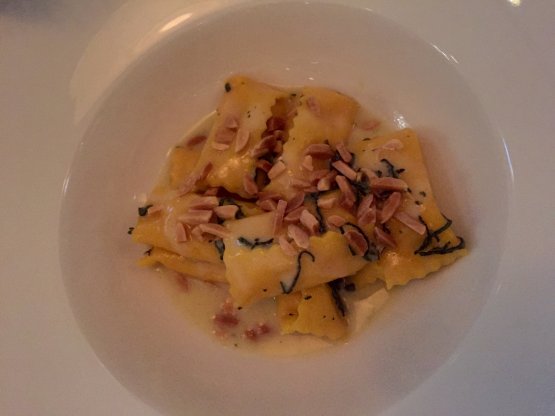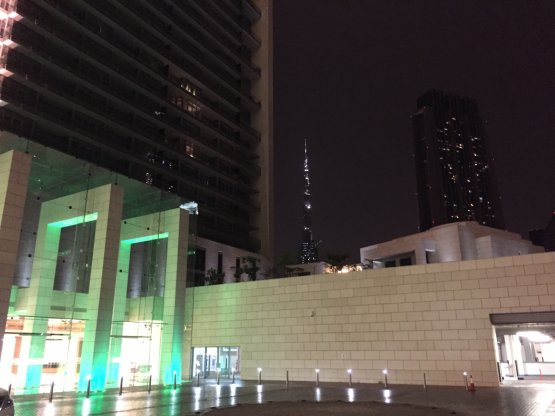And then Pinchiorri conquered a new stage. The curtain is up in the DIFC, Dubai’s international financial centre, area, less than 2 km from the glittering top of the Burj Khalifa. In chronological order, it’s the Enoteca’s fourth restaurant, after the headquarters in Florence (whose doors Giorgio Pinchiorri opened in 1972) and the Japanese establishments in Tokyo (1992, now closed) and Nagoya (2008).
These are still soft opening days for the restaurant in the Emirates, designed on the first floor of the Burj Daman’s food court. The whole structure comprises 3 towers and 14 floors what with luxury hotels, apartments and offices that still need to be populated. Like many skyscrapers in the scorching metropolis, it was built in record time: works ended little less than one year ago, which means you’ll be forced to tell uninformed taxi drivers the address "Al Sa'ada street" (but do also show them a previous picture of the skyscrapers, or you’ll never get there). Inside, it seats 90 people with suffused lighting, hand-decorated chandeliers, sculptures in Murano glass, tables in marble from Carrara and the proverbial attention to the smallest detail.

PASTA FOR TWO. Agnolotti stewed with pumpkin from Mantua, almonds, butter and sage. The dish is placed in the centre of the table, so it can be shared
The owners of
The Artisan are Lebanese brothers and entrepreneurs
Firas and
Hassan Fawaz. Of course they gave
Giorgio and
Annie Féolde («La Signora», that’s exactly how they call her, in Italian) carte blanche. The format to be implemented, instead, is less predictable: «We won’t offer
fine dining in the common sense», the guys in the dining room and kitchen, half Italian and half not, explain numerous times, «because fine dining is not popular in Dubai». It’s very true, for two reasons: the Michelin guide has not yet arrived and given stars, which makes people more free but also doesn’t raise the average standard and the ambitions as elsewhere in the world. Second: for too long, the city’s dining scene was characterised by chefs with a sloping trend, attracted by the necessary petrodollars to adjust shaky balances elsewhere, with often questionable results (and quick closures).
Yet with
Expo coming up (doors will open on 20th October 2020) and the world’s spotlights increasingly pointed at the Persian Gulf, there’s no more space for bluffs, and many Italians who have recently arrived to offer quality and overcome the damned Italian-food = pizza equation (still dominating here) know it: the
Pinchiorri are in good company with
Heinz Beck at
Waldorf Astoria,
Enrico Bartolini at
Roberto’s, the
Armani and
Bice battleships,
Alfredo Russo at
Vivaldi, the good and quiet
Alfonso Crescenzo at
Splendido inside the
Ritz Carlton,
Marco Torasso in the two
Grovesnor House towers, not to mention the big face of Anglo-Italian
Giorgio Locatelli towering inside the
Atlantis next to
Gordon Ramsay and
Nobu Matsuhisa.

Group photo, this time with the kitchen staff. Standing, we have executive chef Luca Tresoldi (in the middle, hugging Lebanese patrons Firas and Hassan Fawaz). Kneeling, with a white jacket, Riccardo Monco, first chef in Florence and co-manager of the kitchen offer in Dubai ("Luca and I are always on Skype", he explains)
Yet what restaurant format has the
Enoteca chosen for Dubai? The sharing of dishes among the guests, «a move», says executive chef
Riccardo Monco, «with which we try to go two steps below our model and test ourselves with new formulas», which are not that new, come to think about it, «think of the importance of this concept in the tradition of Italian families», says the young man. Of course it’s strange to see his armed branch in Arab land
Luca Tresoldi serving first courses such as
Agnolotti stewed with pumpkin from Mantua, almonds, butter and sage and
Spaghetti alla chitarra with seafood at the same time, both placed in the middle of the table, to be picked by different forks (the same would apply with
Penne all'arrabbiata or
Risotto with porcini and black truffle). This is the democratisation of the
Pinchiorri’s who, given the informal model, could even consider table turning (yet it will be hard to get the Signora’s approval on this).
Of course the quality of the raw materials will not diminish at all: it is rigorous and making no concessions. All the ingredients come from Italy and this is already good news on an island where they’re always practicing the pronunciation of Italian sounding names. At The Artisan there will be no ocean fish; only from the Mediterranean Sea, starting from the a starter such as Marinated tuna carpaccio with capers, red pepper and balsamic vinegar or Fried calamari with lime and chilli mayonnaise (to be shared, naturally). With pearl-ingredients such as Burrata d’Andria, fassona beef (the first meat to obtain, only recently, the halal certification, tells us Riccardo Uleri from Longino e Cardenal) or Aceto Balsamico di Modena 35 years by Malpighi, on which they have the exclusive.

From the ground floor of the structure hosting The Artisan you can get a glimpse of the shining top of the Burj Khalifa, 828 metres tall, the emblem of the town to host Expo 2020
How about wine, the house’s pride? To begin with, Emirates’ laws forbid the display of bottles on the walls: there’s alcohol but it mustn’t be seen. Not even behind the cocktail bar right after the entrance: at most, one can place two mini-barriques on top of it (from which wine-based matured cocktails will soon be served). Interesting fact, the wine list designed by Turkish sommelier
Alper Billik and Neapolitan maître
Costanzo Scala opens with a small and precious selection “from the cellar of mister
Giorgio Pinchiorri”:
Sassicaia 2015,
Ornellaia L’Infinito 2011,
Masseto 2011. But also
Cheval Blanc and
Château Latour, both from 2005. After a small selection of wines served by the glass and champagne, the real list begins, with Italian and French wines divided according to type and region. In a country where you can get a Gavi at 140 euros from the supermarket, the rather moderate mark-ups are striking.